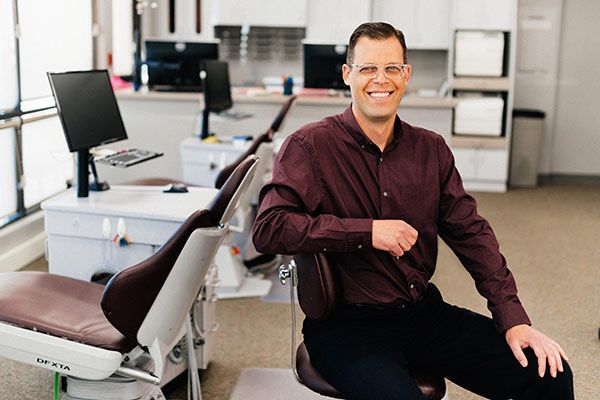What is Invisalign?
Invisalign: Removable or Fixed?
We know you have questions about Invisalign. We’re going to discuss orthodontic treatment with aligners in several upcoming blog posts. Today we’ll start with some history to give context for the upcoming posts. Moving teeth with removable appliances (as opposed to braces) is not new. Modified wire appliances, modified retainers, acrylic, plastic and wire contraptions have been around for a long time. Their variety is limited only by the creativity and resourcefulness of the orthodontist and the willingness of the patient to wear them. Fixed braces as we know them are something designed and patented in the United States over 100 years ago by none other than Edward Angle, widely considered the father of modern orthodontics. In Europe the preference for orthodontic treatment with removable appliances has been much higher than in the States. At the fundamental, biological level, all it takes to move teeth is a small sustained force applied to a tooth over a period of time. Fixed and removable appliances can have similar effects as long as they work within the same basic principles.
The beginning of Align
In the mid-1990’s, Zia Chishti, a young entrepreneur who was working on his MBA at Stanford, was seeing his orthodontist who was using a retainer to finish his orthodontic treatment. Chishti thought, why can’t the entire treatment be done with a clear removable appliance rather than just a minor tuneup after braces? Fast forward and the business of Invisalign was born. Founded in 1997, Align is now a multinational, publicly traded company with over 13 million patients treated with their aligner system. Align has developed and acquired additional companies incorporating technology that allows digital scanning of teeth and 3D printing. Align’s sophisticated software algorithms digitally simulate and predict tooth movement and interface with the treating doctor, allowing full control of the tooth movement process by the orthodontist.
Invisalign Success Story: the Derheims
The Derheims success story at Murray Orthodontics is inspiring, now mom and daughters have a healthy smile!
Align expands
Invisalign was initially marketed exclusively to orthodontists, but in 2001 the company began offering their products and services to general dentists. This dramatically increased their market presence, but also placed some orthodontic treatment in the hands of generalists rather than in the hands of orthodontic specialists. This is nothing new as general dentists are permitted to practice orthodontics if they are proficient and choose to do so. However, the user interface and software algorithms developed over time have made Invisalign much more user-friendly. One can practice orthodontics using Invisalign and have the treatment still “work” without really understanding at a deep level the biological, physiological, and mechanical principles that underlie modern orthodontics. The difficulty lies in understanding why things don’t “work” and what to do about it. Ideally, one would have enough training and experience to identify these issues ahead of time so that all parties understand the challenges presented and agree on expectations. Orthodontic training ensures that your orthodontist understands the principles of tooth movement and can prescribe aligners in such a way that your treatment proceeds safely and effectively.
What do orthodontists think?
As an assertive player in the orthodontic market with an aggressive advertising campaign, orthodontists have had to adapt. Some orthodontists have embraced the product, understanding that a digital workflow and convenience are driving factors with consumer choices. Some have eliminated braces from their practice entirely. Others have been more reticent, with concerns that the profession is being unfairly influenced by an overwhelming economic and marketing force. Most orthodontists are adopting the use of aligners, seeking to deliver care in a manner that patients want, and that is effective and convenient, while also understanding that aligners are simply a tool, one of many, that we have at our disposal to address the specific challenges that each patient brings. Murray Orthodontics has found Align to be an effective and expedient way of allowing us to meet our patients’ needs and wants.
More players on the field.
The patent rights on Invisalign’s aligner materials and systems expired in 2017. This opened the door for many new players in the aligner market. There are many options for the orthodontist who wants to use aligners. However, Invisalign has the advantage of decades of experience refining their product, systems, and software. Also, recently on the market are direct-to-consumer orthodontic aligner companies whose business model is to bypass a treating dentist or orthodontist entirely. Invisalign has committed itself to the doctor-prescribed and monitored model of care. Automating the process to the exclusion of the direct patient to doctor relationship may be a tantalizing business opportunity, but is ethically troublesome, is not in the best interest of orthodontic patients, and is not part of Invisalign’s vision. Direct-to-consumer aligners are simply dangerous. Direct supervision by an orthodontist is the safest way for you to experience orthodontics. More to come on this topic.
What’s next?
With the improvements in software analytics and design, artificial intelligence, digital scanner accuracy and efficiency, coupled with the cumulative data of over 30 years of treating patients with aligners and collaborating with orthodontists, Invisalign has positioned itself to continually improve on its vision of providing predictable, comfortable orthodontic treatment with a removable appliance that is hygienic, easy to use, and esthetically pleasing. We at Murray Orthodontics have treated hundreds of cases with Invisalign aligners over many years. Drs. Murray and Libby have spent dozens of continuing education hours learning how best to customize and deliver aligners for each patient’s unique needs. Stay tuned: more to come on what your experience would be like choosing orthodontic treatment with Invisalign.
Thanks for reading!



